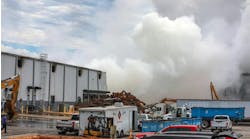Chemical Safety Board Opens Up
February 11, 2016, marked my six-month anniversary as chairperson and CEO of the U.S. Chemical Safety Board (CSB) — the independent federal agency responsible for investigating chemical accidents to prevent similar incidents in the future. Despite its small size — just 40 people with an $11-million annual budget — the CSB has been at the forefront of determining the technical causes of chemical accidents and highlighting opportunities for improvement (see sidebar).
Figure 1. Vanessa Allen Sutherland became head of the Chemical Safety Board in August 2015.
My goal is to ensure the CSB is both productive and collegial, firmly establishing the Board as a preferred resource for chemical data or research, investigative findings and safety-related videos. Performing and releasing the results of incident investigations in a timely manner, issuing general safety recommendations, and publishing articles and op-eds are all part of our work to reach a broad audience. My recent initiative to have the CSB’s products translated into Spanish exemplifies our intention to get safety information to a wider demographic. During my first six months, the CSB has completed two investigations, held interim public meetings for two investigations, issued interim recommendations and findings, updated or closed numerous recommendations, initiated a number of outreach initiatives and held four business meetings.
Let’s look a bit more at what we’ve done and our plans for the future.
[javascriptSnippet ]
Completed Investigations
On October 21, 2015, the CSB voted to approve the final investigation report into the massive 2009 explosion at the Caribbean Petroleum, or CAPECO, terminal facility near San Juan, Puerto Rico; the report includes recommendations for addressing regulatory gaps in safety oversight of petroleum storage facilities by the U.S. Occupational Safety and Health Administration (OSHA) and Environmental Protection Agency (EPA).
The CSB’s investigation found several operational and regulatory deficiencies contributed to the explosion. We have recommended that OSHA and EPA require sites with aboveground storage-tank facilities, like CAPECO, conduct risk assessments to determine the potential dangers of their operations to surrounding populations and sensitive environments.
The CSB’s investigation report into the April 13, 2013, explosion and fire at the West Fertilizer facility in West, Texas, was approved at a public meeting in Waco, Texas, on January 28, 2016.
The massive explosion stemmed from the detonation of ammonium nitrate and resulted in the deaths of fifteen people, most of whom were emergency responders. The event caused the destruction of a nursing home, an apartment complex, and the town’s high school and intermediate school. Total damage is estimated to exceed $230 million.
The U.S. Chemical Safety and Hazard Investigation Board, commonly called the Chemical Safety Board (CSB), began operation in 1998. It investigates accidents and has no regulatory role. Staff, which includes technical specialists, seeks to determine the root causes of accidents. Besides identifying the reasons for specific incidents, the CSB issues general recommendations to help industry avoid similar events in the future. In addition, it produces videos and other resources that companies can use to educate staff about incidents and risks. (The videos can serve as effective tools to combat complacency about safety; see: “Stimulate a Sense of Vulnerability.”) For more on CSB activities and resources, go to: www.csb.gov.
The CSB report examined best practices for the use and storage of fertilizer-grade ammonium nitrate, emergency planning, and land use near facilities processing and storing hazardous chemicals. The report integrated data gathered from the testimony of subject matter experts during an interim public meeting held in West, Texas, in April 2014. Lessons learned from this investigation can be applied in the 1,351 facilities across the country that store ammonium nitrate and in their surrounding communities. The agency has worked with other federal agencies, including the Office of Management and Budget and the Department of Homeland Security, to share information about the incident and support the President’s Executive Order 13650: Improving Chemical Facility Safety and Security. (The EPA now is proposing to amend the accidental release prevention requirements spurred by that executive order; see “EPA Eyes Risk Management Program.”)
Interim Public Meetings
The CSB has met with DuPont and ExxonMobil regarding accidents at their plants.
DuPont — During a field hearing on September 30, 2015, the CSB discussed its preliminary findings and released recommendations from the ongoing investigation at the DuPont facility in LaPorte, Texas. The CSB’s investigators presented a detailed analysis of the November 2014 release of 24,000 lb. of highly toxic methyl mercaptan that killed four employees.
The CSB found that water had mixed with liquid methyl mercaptan in piping days prior to the accident. Due to cold weather, this mixture formed a solid hydrate that blocked the piping. A DuPont technical team eventually developed a plan to clear the blockage by spraying hot water onto the pipes to melt the hydrate. On November 15, operations personnel worked through the night attempting to clear the blockage. Following a failed startup, workers paused to take a break; at the same time, the plant began to experience a different problem — high pressure in other piping.
DuPont had long-standing issues with vent piping to an incinerator installed in 2011. To deal with these problems, operations personnel had been issued instructions to drain daily liquid from these pipes, which were located in another section of the plant. DuPont’s instructions did not specify additional breathing protection for this task. On the night of the incident, not realizing the original blockage was cleared, workers went to drain the other piping. They did not know that liquid methyl mercaptan once again was flowing through the original, now unblocked, pipes and causing the high pressure in the other piping.
The CSB found that neither workers nor the public are protected by DuPont’s toxic-gas detection system. The building where the workers died lacked an adequate toxic-gas detection system to alert workers to the presence of dangerous chemicals. Also, two rooftop ventilation fans were not operating, despite an “urgent” work order written nearly a month earlier. Nonetheless, investigators said that, due to the large amount of toxic gas released, a lethal atmosphere would have developed inside the building even if the fans were working.
The CSB’s preliminary findings and recommendations state that DuPont invested $20 million in 2011 to put in an incinerator to increase production and reduce environmental emissions at the insecticide unit. However, the installation of the incinerator created problems: liquid accumulation and frequent high-pressure events in the waste-gas vent-header piping.
As detailed at the meeting, the CSB found a chain of events led to the fatal accident. During the unloading of a tank truck containing a raw material, a water dilution system inadvertently was activated; the raw material’s storage tank overflowed, resulting in a shutdown of the insecticide unit. When operators attempted a restart on November 12, they discovered that a salt-slurry material had blocked a reaction system, a common occurrence following a shutdown.
In attempting to clear the salt-slurry blockage, 2,000 lb. of water inadvertently were sent to a storage tank containing methyl mercaptan, creating a solid, ice-like hydrate in connecting piping called the methyl mercaptan feed line.
On November 14, a troubleshooting team of managers and engineers developed a plan and instructed operators to apply hot water under the blocked pipes’ insulation, to break up the hydrate. The operators — realizing that methyl mercaptan, when heated, would expand and need a safe place to vent — directed that two valves leading to vent piping be opened. This plan had not gone through a safety review as required by the company’s own standards. Moreover, the CSB learned no written procedures existed to guide operations or to track the success of the plan or progress toward clearing the entire methyl mercaptan feed line.
At 2:45 a.m., the methyl mercaptan level in the storage tank began dropping as the hydrate liquefied and the toxic chemical flowed toward the open waste-gas vent header. As methyl mercaptan started to flow in the vent piping, high-pressure alarms for process equipment connected to the vent header appeared on consoles in the control room. Operators did not realize the two problems — the hydrate blockage and the high pressure — were related.
Two workers went to drain the waste-gas vent-header piping; liquid methyl mercaptan escaped into the building, where it readily vaporized, filling the room with highly toxic gas. Although one of the workers made a distress call, both died, unable to escape the building. Four operators responded to the distress call and entered the manufacturing building. Two of them were brothers; they died together on the same floor. The other two operators survived.
CSB’s recommendations address the need to:
• Perform inherently safer design review;
• Ensure the manufacturing building is safe for workers;
• Provide a relief system design that is safe for workers and the public;
• Conduct more-robust process hazard analyses;
• Get workers to actively participate; and
• Strive for greater public accountability and transparency.
[Editor’s note: for articles regarding some of these recommendations, see “Consider Inherent Safety at Your Plant,” “Use Elegant Design to Bolster Inherent Safety,” and “Make Wider Use of Process Hazard Analysis.”]
ExxonMobil — On February 18, 2015, the ExxonMobil refinery in Torrance, Calif., released spent-catalyst particles into the surrounding community, resulting in four minor injuries and extensive property damage. The CSB’s investigation will focus on the technical cause of the equipment failure; organizational factors; process hazard analyses and mechanical integrity at the refinery; the community impact; and the State of California’s Process Safety Management (PSM) regulatory initiative. The CSB held an interim public meeting in the community in January 2016 to discuss preliminary findings and hear from the community.
At that meeting, CSB investigators cited a series of events that unfolded over several days that led to hydrocarbons accumulating inside an electrostatic precipitator (ESP). The result was a blast that dispersed large quantities of catalyst dust up to a mile away from the facility.
CSB investigators determined that ExxonMobil’s process hazard analyses were deficient; adequate ones could have identified more-effective safeguards against the flow of hydrocarbons — such as a blind or de-inventorying the main distillation column.
The CSB found that large pieces of debris from the explosion were thrown into other units of the refinery directly surrounding the ESP. One of these pieces hit scaffolding in the refinery’s alkylation unit, narrowly missing a tank containing tens of thousands of pounds of modified hydrofluoric acid (HF). The CSB determined that if the piece had struck the tank instead, it might have produced a rupture, resulting in a potentially catastrophic release of toxic modified HF into the neighboring community.
After HF acid vaporizes, it condenses into small droplets that form a dense low-lying cloud that will travel along the ground for many miles and can cause severe damage to the respiratory system, skin and bones of those who are exposed. The Board continues to request documentation from ExxonMobil regarding this near-miss and hopes to move forward with a thorough analysis in its final report.
Most Wanted Safety Improvements
In December 2014, the Board identified the modernization of PSM regulations as the second issue for inclusion in its “Most Wanted Safety Improvement Program” — because such regulations have undergone little updating since their inception in the 1990s. (In 2013, the Board identified the first issue — the need for a comprehensive combustible dust standard.)
The CSB’s interim meeting into the 2015 explosion at the Torrance ExxonMobil Refinery included a panel of experts who discussed California’s new PSM reforms. The panel had representatives from state agencies, industry, and worker and environmental groups. The CSB continues to monitor developments in California as the draft regulations move through the regulatory process because this process may serve as a guide for other state and national PSM reforms.
The Board reviews on an ongoing basis whether other issues should be added to the “most wanted” list.
Moving Forward
Over the next few months, my fellow Board members, staff and I will prioritize investigations, initiate a land-use study to evaluate how to examine the consequences of chemical accidents taking siting and other considerations into account, continue to advance recommendations, and increase outreach activities with a focus on academic institutions, industry, labor organizations, state and federal agencies, communities and key conferences. The Board has held business meetings to keep our stakeholders informed of our operational activities.
My goal is to ensure we have consistent policies, satisfactory annual audits, improved compliance and structure as well as clear roles and responsibilities. I am tackling internal issues that have undermined efforts in the past; this should lead to staff spending more time on mission-critical work and finding their jobs easier and more fruitful.
The CSB has finalized its 2016 action plan, and will commence work on its next strategic plan, to ensure that deadlines are met and goals remain on track. By using and refining accident assessments and full-scale deployments protocols, we can make the most of our staff and resources. CSB products are powerful tools that need to get into the hands of those who need them most.
Thus, in addition to focusing on organizational excellence, over the next one to three years, I envision further outreach to untapped audiences.
First, I plan to expand my recent initiative to have the CSB’s investigation-related press releases translated into Spanish for posting on our “En Español” webpage, to include translations of older products as well as future reports. Long term, my goal is to ensure that CSB’s safety information is available to a wider demographic — this will include targeted outreach to skilled workers, such as welders and electricians, who have a critical role to play in plant safety.
Second, I have been very pleased with the support offered by our stakeholders to my initiative to engage academic institutions as well as trade associations regarding chemical safety training and certifications. Organizations such as the Mary Kay O’Connor Process Safety Center, the National Association of Chemical Distributors, the American Society of Safety Engineers and ORCHSE Strategies have welcomed the opportunity to discuss how CSB data may inform the creation or addition of relevant safety courses to benefit students and workers. Working with our smart, creative team, I hope to develop summaries or compilations of data that we possess. I also want to promote the CSB’s mission by constructively using safety videos and social media platforms to enhance training.
Third, the CSB should reinvigorate its role in hosting forums or symposia on various chemical safety issues. The CSB can help facilitate the sharing of ideas to promote learning and collaboration. In the past, the Board has hosted such events to spur conversations about how to make advances in chemical safety. I intend to support a culture that promotes continual learning.
Finally, I personally am interested in encouraging the pursuit of science, technology, engineering and mathematics (STEM) education for high school and college students. Engaging children early and often hopefully will ensure that future generations are interested and eager to get involved in these areas.
My vision is to spur reasonable, far-reaching chemical safety change while engaging with parties that can provide a diverse range of domestic and international perspectives.
I believe the CSB can be one of the most effective agencies in the federal government. I have worked at small and large companies and in the federal government; I hope to provide that unique perspective as well as creativity and nuance to the issues we evaluate, to leave a legacy at the CSB of operational excellence and seamless execution of its important mission.
VANESSA ALLEN SUTHERLAND is chairperson and CEO of the U.S. Chemical Safety Board, Washington, D.C. E-mail her at [email protected].



